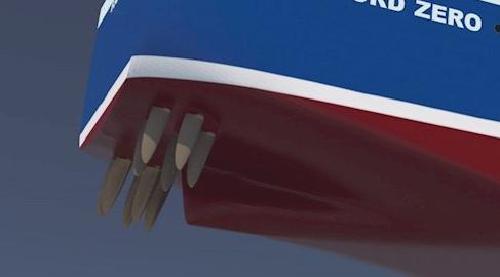Navigating the waters can be a thrilling adventure. However, the joy of sailing can quickly turn into a nightmare when the boat’s maneuverability is compromised. One of the most critical components that ensure smooth navigation are the boat’s bow and stern thrusters. This comprehensive guide will delve into the types of these thrusters, their applications, and why they remain essential even with pod drives. We will also touch on the potential fire dangers and the importance of fire prevention systems on thrusters.
Understanding Boat Thrusters
Before we dive deep into the differences in types and applications, it’s essential to understand the role of boat thrusters. Bow and stern thrusters are propellers installed in the bow (front) and stern (rear) of a boat. They are designed to aid in maneuvering the boat, especially while docking or navigating through tight spaces.
 Stern Thruster (source: Wikipedia)
Stern Thruster (source: Wikipedia)
Electric vs. Hydraulic Thrusters: A Comparative Analysis

Electric Thrusters
Electric thrusters are powered by the boat’s electrical system. They are easy to install, require less maintenance, and are relatively quiet during operation. However, they may not be suitable for larger vessels due to their limited power output, and their continuous operation can drain the boat’s battery quickly.
Hydraulic Thrusters
Hydraulic thrusters, on the other hand, use the boat’s hydraulic system for power. These thrusters can generate more power, making them ideal for larger vessels. They also have a longer operation time without causing significant power drain. However, they can be complex to install and may require more maintenance due to their intricate system.
Thrusters and Pod Drives: Complementary, not Competitive

With the advent of pod drives, some boaters may question the need for thrusters. Pod drives, just like thrusters, enhance the maneuverability of the boat. However, they mainly replace the traditional shaft, rudder, and propeller setup.
Despite their advantages, pod drives don’t make thrusters obsolete. In fact, they complement each other. Combining both systems allows for more precise control and easier maneuverability, especially in challenging conditions.
The Threat of Fire and the Importance of Fire Prevention Systems
Despite their many benefits, thrusters, especially electric ones, can pose a fire risk. Overheating, electrical shorts, and improper installation are some potential fire hazards. Therefore, a robust fire prevention system is not just a recommendation; it’s a necessity.
Fire prevention systems monitor for early signs of fire, such as heat and smoke, and automatically activate extinguishing measures. Regular maintenance checks, proper installation, and using quality components are also part of an effective fire prevention strategy.
Estimated Costs
To give you an indication on the current cost of a bow thruster, see the table below, installing cost can
| Brand & Model | Thrust (kgf) | Voltage | Boat Length (ft) | Price (USD) | Price (CAD) |
|---|---|---|---|---|---|
| Vetus BOW5512D | 55 | 12V | 27 - 41 | $3,399.95 | $3,924.95 |
| Max-Power CT100 Duo-Prop | 90 | 12V | 30 - 53 | $2,495.00 | $2,956.00 |
| Lewmar 185TT Gen 2 | 110 | 12V | 35 - 50 | $2,942.67 | $3,399.95 |
| Vetus Bow Pro (BOWA0301) | 30 | 12V | Up to 30 | $2,507.52 | $2,900.00 |
| Max-Power CT165 Duo-Prop | 160 | 24V | 42 - 66 | $3,295.00 | $3,800.00 |
| Vetus BOW9524D | 95 | 24V | 39 - 55 | $3,424.64 | $3,950.00 |
*Please verify the current specifications and prices with the manufacturers or authorized dealers before making a purchase.
The average installation cost of a bow thruster depends on several factors, including the boat size, hull material, labor rates, and additional modifications required. Here’s a general breakdown:
Estimated Installation Costs
| Boat Size (ft) | Estimated Cost (USD) | Estimated Cost (CAD) | Notes |
|---|---|---|---|
| Under 30 ft | $3,000 - $5,000 | $4,000 - $6,500 | Fiberglass hulls tend to be easier; labor costs lower. |
| 30 - 45 ft | $5,000 - $8,500 | $6,500 - $11,000 | May require custom fiberglass work or reinforcement. |
| 45 - 60 ft | $8,500 - $15,000 | $11,000 - $20,000 | More complex installation, possible extra wiring. |
| 60+ ft | $15,000+ | $20,000+ | Requires heavy modifications, larger tunnel cutting, and stronger power system. |
Cost Breakdown
- Thruster Unit – $2,500 - $8,000 (depending on brand and power)
- Installation Labor – $2,000 - $7,000 (varies by boatyard and region)
- Tunnel Fabrication (if needed) – $1,000 - $5,000 (depends on hull material)
- Electrical Work (Battery/Wiring) – $500 - $3,000 (depends on power requirements)
- Haul-Out & Yard Fees – $500 - $3,000 (depends on boatyard)
- Miscellaneous (Control Panels, Joystick, etc.) – $500 - $2,000
Factors Affecting Cost
- Hull Material: Fiberglass is generally cheaper than steel or aluminum.
- Power System: A 24V system may require additional wiring/battery upgrades.
- Control Type: Basic joystick controls cost less than advanced proportional controls.
- DIY vs. Professional Installation: DIY can save labor costs, but risks expensive mistakes.
Conclusion
In the vast expanse of the sea, maintaining control over your vessel is paramount. Bow and stern thrusters, whether electric or hydraulic, provide that control and enhance your boating experience. Even with advanced systems like pod drives, the importance of thrusters cannot be overstated.




Use the share button below if you liked it.